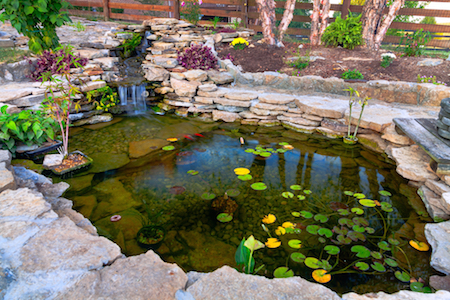
Above ground koi ponds take a lot of time, commitment and money.
If you’re interested in koi pond design from scratch you’re facing a considerable financial investment. You might also have to find out from your local planning authority if you’re permitted to build an above ground koi pond on your property. Chances are you already have a pond that you want to stock with koi.
3 key points
1. How much water is needed in a pond?
The volume, depth and size of your pond varies greatly depending on whether you’re intending to keep koi or goldfish. Their needs are very different.
Volume
- Koi are long living fish that can grow quite large. They require a pond of at least 1000 gallons, which is about 48 square feet.
- If your pond is much smaller than this, then consider comets or goldfish instead.
(Remember, a gallon is not that big so don’t be alarmed at the thought of 1000 gallon pond.)
Depth
- To enable koi to live in an above ground pond year round, it needs to be at least 3 feet (or 1 metre) deep
Reason: This depth is needed to help them to survive the cold of winter and also in the heat of summer.
If your pond gets too hot, the koi will die of a fish version of heatstroke. But with a deep pond they can retreat to the cooler water at the bottom of the pond in summer.
Size
- Female koi grow much larger than males (approx 1:2 ratio)
You might start out with a number of small koi but within 2 or 3 years you’ll find they’ve doubled in size. Overstocking your pond will cause algae growth and filters will need cleaning daily to keep in good working order.
Even limiting your koi to 1:250 gallons you’ll need to keep up with your routine maintenance of cleaning the skimmers, filters and partial water changes.
Partial water changes
Weekly pond water change of 10-20% is usual and won’t stress your koi as much as a larger volume being exchanged monthly. There’ll be less change in the water temperature of the entire pond which is much less stressful to your fish.
2. Effective water filtration
All ponds require a filtration system, not just above-ground koi ponds.
Filtration prevents the water from turning stagnant and maintains the chemical balance of the pond water. Any massive changes in water chemistry will stress your fish.
Stagnant water encourages algae growth and mosquitoes.
You can learn more about mechanical filtration and biological filtration systems in “How To Build Your Own Garden Pond“.
3. Predator protection
Koi are considered delicacies by some species of wildlife including domestic cats, raccoons and birds. Some sort of scarecrow is recommended near your koi pond. Very thin netting is also an option, but this will make pond maintenance more difficult.
Other types of fish can also prey on koi so pond design is usually restricted to the single species.
Tip: Don’t overstock your pond.
Reason: The koi may turn on each other in the competition for food and swimming space as they grow.
If you’re building your own garden pond then I recommend ‘How To Build Your Own Garden Pond‘ ebook. You’ll find all the information you’ll need is in this book.
